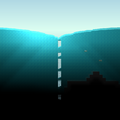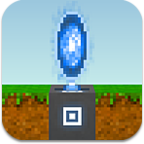Water: Difference between revisions
>McClaw |
>McClaw |
||
| Line 22: | Line 22: | ||
==Evaporation== | ==Evaporation== | ||
If standing water is low enough in a block space, it may "evaporate" and despawn. When water is less than 1/28 of a block, it | If standing water is low enough in a block space, it may "evaporate" and despawn. When water is less than 1/28 of a block, it disappears from that block. This may allow water from an adjacent block to flow in, eventually lowering the water level in that block to less than 1/28 too. This effect can slowly clear large areas of shallow water. | ||
Also, if water fills less than one whole block of water on top of magma, it does not turn into [[basalt]] and instead evaporates into steam. | Also, if water fills less than one whole block of water on top of magma, it does not turn into [[basalt]] and instead evaporates into steam. | ||
Revision as of 11:01, 18 August 2013
Water is a fluid block that can be a barrier to travel or a useful resource.
Where Found
Water occurs naturally on the surface of a generated world in the form of ponds, lakes, and oceans. It can also spawn underground.
Flowing
It's possible for water to flow from one block to another, either when an adjacent block is removed, a block is added in space occupied by water, or when a bucket of water is emptied. Water will seek to fill the lowest available space but will not decrease in volume doing so, which can result in spaces being partially filled with water.
Water will flow over drop-offs and "splash" across the top of blocks. This can cause unexpected problems as water will dislodge placed items such as ladders or oil lanterns, dropping them for pick-up by the next Blockhead that passes them. Other placed items such as steel lanterns are unaffected.
Whether water will flow between two adjacent partially filled blocks appears to be determined by comparing their relative levels. If there is insufficient difference, there will be no flow. This can result in a very gentle, descending gradient across long expanses. (In one test, there was a drop of 28 pixels over a span of some 93 blocks with 80-pixel blocks after the water settled.) A significant difference in water height will cause "splash" particles to be produced as the water flows.
Flowing water will "push" items floating on top of it in the direction of the flow.
When multiple water blocks are directly over air blocks, there may be a flickering pattern of air and water as the two trade places.
Freezing
Free-standing water in an area experiencing sufficient cold (such as falling snow) or space may freeze into ice if the water level is high enough. Trace water may disappear. Under warmer conditions, ice may melt into water.
Water close enough to cold air will freeze into ice, the distance dependent on the degree of cold. Conversely, ice close enough to warm air will melt.
Evaporation
If standing water is low enough in a block space, it may "evaporate" and despawn. When water is less than 1/28 of a block, it disappears from that block. This may allow water from an adjacent block to flow in, eventually lowering the water level in that block to less than 1/28 too. This effect can slowly clear large areas of shallow water.
Also, if water fills less than one whole block of water on top of magma, it does not turn into basalt and instead evaporates into steam.
Harvesting
It's not possible to pick up water directly, but may be picked up and carried when frozen into ice and allowed to melt when placed later.
Using a bucket on water will change the bucket into a bucket of water. This can be done on even partially filled spaces containing more than one-eighth of a block of water.
Drowning
A Blockhead who has its head fully immersed in water will suffer from a lack of air and begin reducing their air bar.
Uses
Water cannot be used directly for crafting, but is needed for some crafting recipes in the form of a bucket of water.
Kelp cannot be planted in a block that isn't under sufficient water.
Placing water directly atop magma will create a block of unharvested basalt.
Notes
Free-standing water that's close enough to magma, a campfire, or burning blocks will begin boiling, giving off puffs of steam.
Due to some quirks of how it's implemented, it's possible to generate water in two ways:
- Water that partially fills a space will freeze into a full block of ice, which can then melt into a full block of water.
- Causing water to spill into two or more open blocks may allow each partially filled space to be picked up by a bucket, which when emptied will produce a full block of water.
Gallery
-
Water boils near magma
-
Water draining down an irregular vertical shaft, note the flowing accumulation at the bottom
-
An ocean draining into an unidentified submarine cave; it started when the player's Blockhead approached


